At Coastkeeper’s January 2023 board of directors meeting, a new “Justice, Equity, Diversity, and Inclusion Plan,” also known as JEDI, was unanimously adopted. This plan was created after months of research and development by the staff, led by the deputy director of programs Dyana Peña.
The purpose of this plan is to comply with Waterkeeper Quality Standard #14, which requires our organization to adopt a JEDI plan including the following:
- A brief narrative or a map identifying where Black, Indigenous, People of Color (BIPOC) or other disparately impacted communities are located within your watershed.
- A specific explanation (or at least three direct examples) of how your organization conducts outreach to these communities and works to help them with their watershed-related issues.
- A copy of your approved organizational JEDI plan, or equivalent document, to grow and maintain diversity within the structure of your organization (Board, Staff, Volunteers, Members) and ensure policies are in place to include diverse community perspectives.
Below is a portion of our adopted JEDI Plan. For the full document, click here.
Introduction
Orange County Coastkeeper believes all people have the inalienable right to clean water. We are committed to creating a community that has access to fishable, swimmable, drinkable water for present and future generations. We recognize that the long history of water injustice tells us that the mistreatment and misallocation of these natural resources disproportionately inflict low-income communities and communities of color. These same communities face systemic barriers that create inequitable access to natural spaces and spaces where decisions impacting these resources are made.
With the understanding that all people should be meaningfully involved and recognizing that certain communities have been systematically excluded from this movement, we are committed to intentionally working against this exclusion and centering justice in the approach to our mission. While several of our successes have benefited all communities in Orange County, we now need to intentionally center our most marginalized communities.
Our Watersheds
In order to serve the diverse population of Orange County in a just, equitable, and inclusive way, Coastkeeper must be aware of this diversity and the issues in our communities. To demonstrate this, the following section consists of a variety of maps taken from CalEnviroScreen 4.0 depicting a multitude of water pollution issues and how they are disproportionately affecting certain areas of the county. The scores on CalEnviroScreen are based on both Exposures and Environmental Effects, which include the following measures: ozone concentrations, PM25 concentrations, children’s lead risk from housing, diesel PM emissions, drinking water contaminants, pesticide use, toxic releases from facilities, traffic density, solid waste sites and facilities, groundwater threats, hazardous waste, impaired water bodies, and cleanup sites.
The pollution burden in our jurisdiction is concentrated in north and central Orange County. Coastkeeper focuses resources on defending equitable clean water resources throughout the county by working with all members of the community, including those from both north and south county. We see the effects of poverty on access to outdoor spaces firsthand through our education programs: students living in north county are less acquainted with their local natural spaces than those living in south county.
While South Orange County relies heavily on imported water, North Orange County relies mainly on local water sources due to having the “largest water purification system” in the world (Groundwater Replenishment System [GWRS]). Because of this, we see that there are naturally many more opportunities for threats to groundwater in northern Orange County. Water bodies, aquatic habitats, and watersheds provide a multitude of beneficial uses, including drinking, swimming, fishing, and habitat for aquatic and semiaquatic species. OC Coastkeeper is not only an advocate for humans in the fight for clean water but for all animals and habitats.
Coastkeeper will use these maps and the information gained from them to inform our work moving forward to address the inequities in access to safe water resources. We hope to provide justice to our communities by engaging in work that includes voices across the lines of race, class, gender, age, and ability.
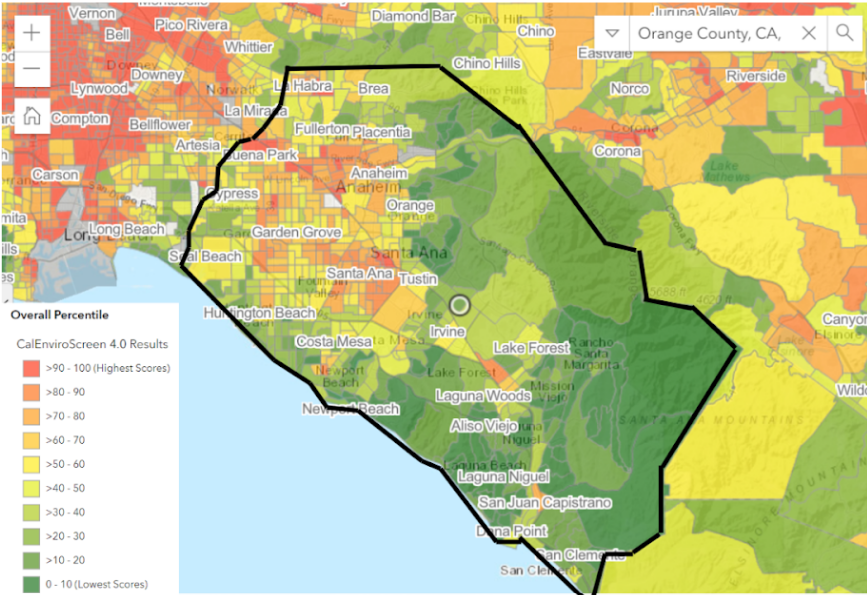
Figure 1
Cumulative Environmental Impacts
Map displaying cumulative impacts based on pollution burden (environmental effects and average of exposures) and population characteristics (average of sensitive populations and socioeconomic factors) throughout communities in Orange County, California by census tract. Data sourced from CalEnviroScreen 4.0.
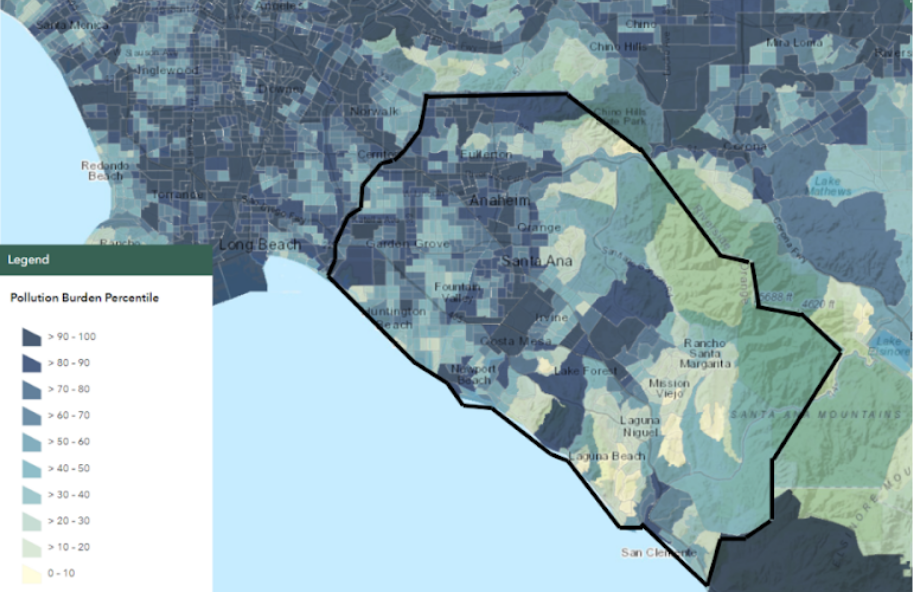
Figure 2
Pollution Burden
Map depicting the pollution burden percentiles in Orange County, California by census tract. The combined pollution burden score “represents the potential exposures to pollutants and the adverse environmental conditions caused by pollution.” Data sourced from CalEnviroScreen 4.0 – Pollution Burden.
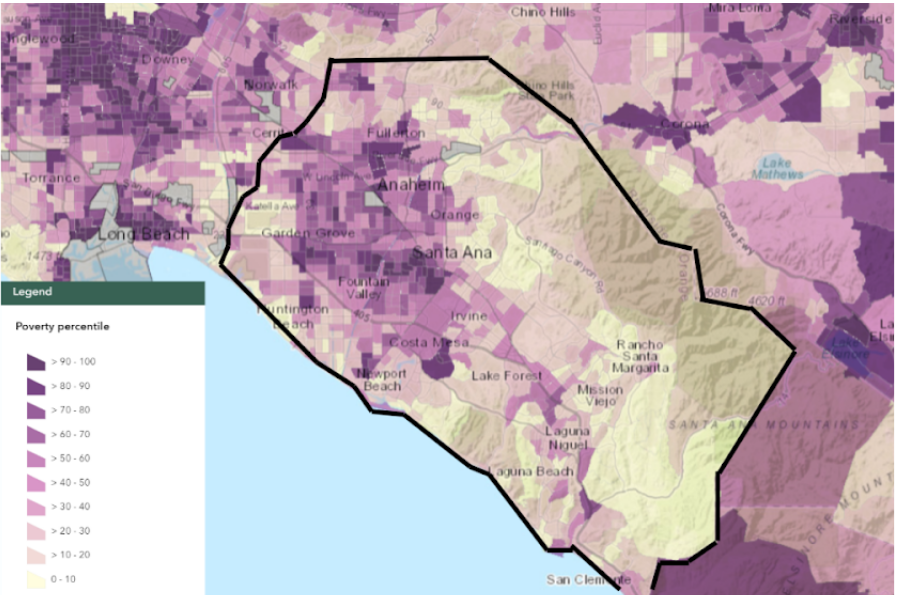
Figure 3
Distribution of Poverty
Map displaying the percentage of poverty in Orange County, California by census tract. Data sourced from CalEnviroScreen 4.0 – Poverty Percentile.
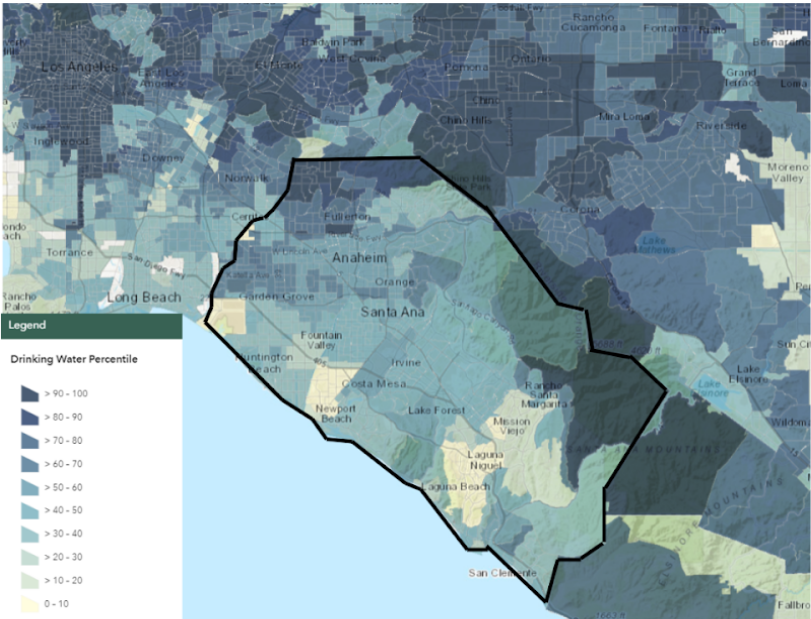
Figure 4
Distribution of Drinking Water Contaminants
Map demonstrating the drinking water percentiles in Orange County, California by census tract. Drinking water percentile includes the “relative concentrations of different contaminants and whether multiple contaminants are present.” Data sourced from CalEnviroScreen 4.0 – Drinking Water Percentile.
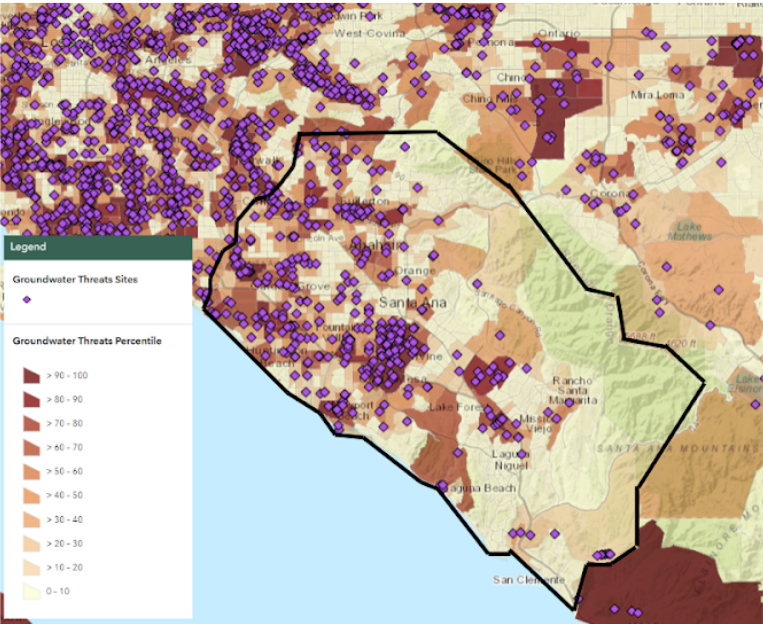
Figure 5
Distribution of Groundwater Threats
Map showing groundwater threat percentiles by census tract and specific groundwater threat sites in Orange County, California. Data sourced from CalEnviroScreen 4.0 – Groundwater Threats.
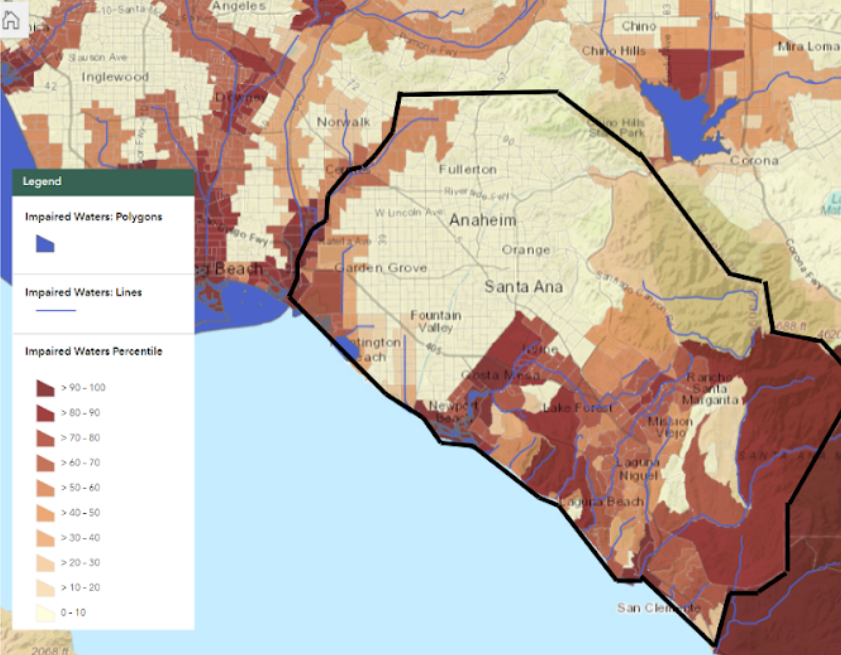
Figure 6
Impaired Water Bodies
Map depicting impaired waterways and water bodies throughout Orange County as lines and polygons; and impaired water percentiles by census tracts. Data sourced from CalEnviroScreen 4.0 – Impaired Waters.
Our Plan
We are committed to conducting work that is informed by and reflects the values of the diverse community that we serve. The following plan shares our vision for the future of Orange County Coastkeeper and how we will hold ourselves to greater inclusion and diversity.
We will focus our efforts on four areas:
- LEARN: Require all staff and board members to complete Diversity, Equity, and Inclusion training on an ongoing basis. Commit to ongoing learning, questioning the status quo, and taking accountability for how we may benefit from and contribute to harmful systems.
- TRANSFORM: Challenge our dynamic with power, privilege, and oppression by being self-aware and showing solidarity. We will strive to create a just world where everyone has access to safe, clean water resources as a basic human right by ensuring our work supports building new systems that uphold our mission of a sustainable healthy water supply.
- ACT: Taking accountability, showing up with trust and respect, and being ready to listen and learn will lead to the recruitment and engagement of diverse stakeholders and staff:
- Begin by electing diverse board members
- Follow with new staff opportunities
- Divest from harmful systems and share resources
- ENGAGE: Respectfully engage in collaboration that supports just, reciprocal, collective work. We will take the time to build trust within our community and engage in intentional listening to build consensus through healthy deliberation and solidarity. Our partnerships will intentionally dismantle inequitable power structures.
Please see our full JEDI Plan document for a 2023 roadmap detailing how we will achieve these goals.
If you would like to join Coastkeeper in our fight for clean water for all, please consider joining as a member by either volunteering or donating to our organization. We all need clean water to survive, and more importantly, we all deserve access to clean water as a human right.






